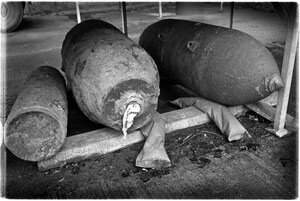 |
Still coping with munitions from World War One. Enormous numbers of duds are turned up every year. Many of them are still filled with deadly poison gas. |
Today Houthulst has Belgium's largest collection area of unexploded gas munitions. The amount is staggering. There are 18,000 unexploded gas shells, totaling at least 300,000 kilos. It has been estimated that for every square meter of terrain along the old entrenchments, reaching from Belgium's coast through the country and France to the Swiss border, a metric tonne of artillery projectiles fell.
With the dud rate ranging from 25-33 percent of fired shells, Houthulst's still mostly-lethal stockpile grows daily as more ordnance comes to the surface across the region. Only a minority of duds are gas shells. Belgian farmers turn up or discover more shells so frequently that the Belgian army's collection patrol makes two trips daily through the region.
The thousands of shells at Houthulst are stacked in rows upon the ground. Many of the shells at Houthulst are leaking. They are placed in concrete bins, but there are no bunkers to enclose them. A disposal processor nearby x-rays the shells to see whether they contain explosive or gas. The ones that contain gas are drilled and vacuum evacuated into sealed containers. These are taken to Antwerp where the gas in burned at super-high temperatures.
But there is another site in Belgium that may contain a hundred times as much gas shells. It lies on the sea bed near the port of Zeebrugge, only a few hundred meters from the shoreline. This site threatens Holland also because of tidal currents. Millions of tons of munitions were dumped there after the Great War. The dumping went on for six months at a rate of about 340 tomes per day. The government classified all the details and the site was forgotten about.
The location was accidentally again brought to light in 1971 by dredging and is now well known but unmarked; the Belgian government has classified all information about the site. A researcher at the Belgian Free University has calculated that more than 1,000,000 liters of pure poison gas lies there, most of it mustard gas. Mustard gas is not degraded by seawater. If mustard shells start cracking, the hazards will be immense.
World War One, it is feared, has yet to claim its final victims.
Links:
http://www.greatwar.nl/frames/default-houthulste.html
http://en.wikipedia.org/wiki/Iron_harvest
http://forums.wildbillguarnere.com/index.php?/topic/7229-houthulst-can-anybody-verify-this/
http://www.militaryphotos.net/forums/showthread.php?94760-Legacy-of-the-Great-War